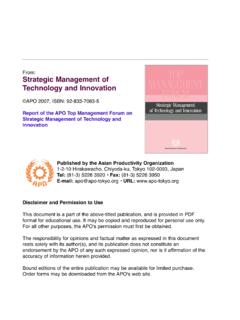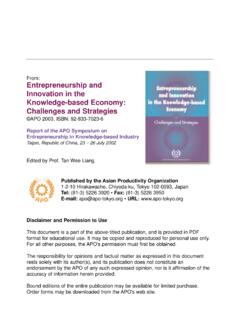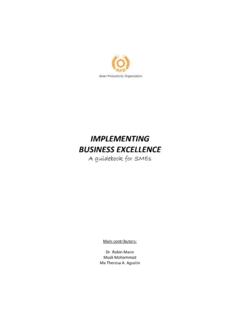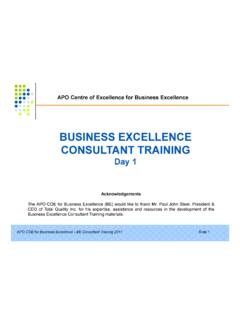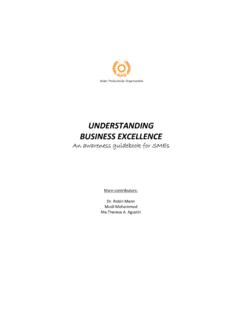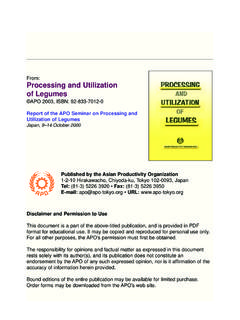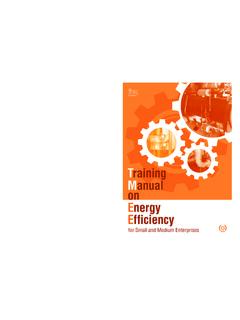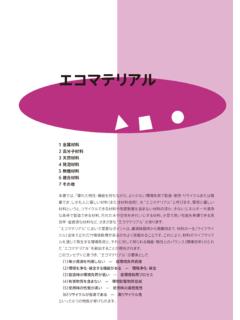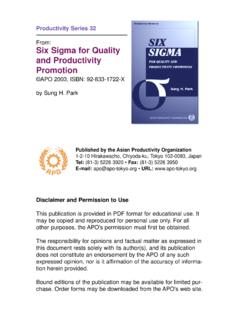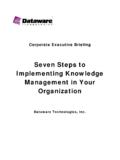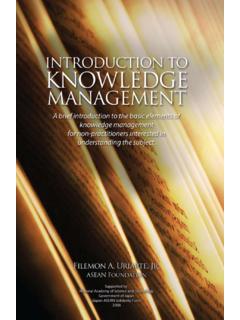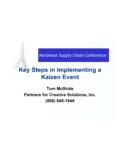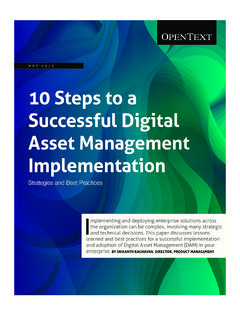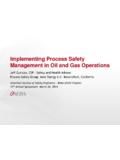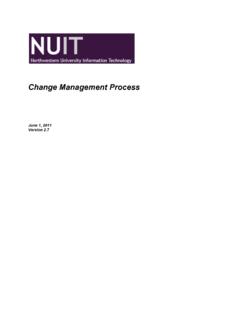Transcription of Knowledge Management Tools and Techniques …
1 From: Knowledge ManagementTools and Techniques Manual APO 2010, ISBN: 92-833-7093-7Dr. Ronald Young, United Kingdom, served as thevolume by the Asian Productivity Organization1-2-10 Hirakawacho, Chiyoda-ku, Tokyo 102-0093, JapanTel:(81-3) 5226 3920 Fax:(81-3) 5226 and Permission to UseThis document is a part of the above-titled publication, and is provided in PDFformat for educational use. It may be copied and reproduced for personal use all other purposes, the APO's permission must first be responsibility for opinions and factual matter as expressed in this documentrests solely with its author(s), and its publication does not constitute anendorsement by the APO of any such expressed opinion, nor is it affirmation of theaccuracy of information herein editions of the entire publication may be available for limited purchase. Orderforms may be downloaded from the APO's web ManagementTools and TechniquesManualAsian Productivity OrganizationAsian Productivity Management Tools and Techniques ManualThe opinions expressed in this publication do not necessarily reflect the official view of the APO.
2 For reproduction of the contents in part or in full, the APO s prior permission is Ronald Young, United Kingdom, served as the volume editor. Asian Productivity Organization, 2010 ISBN: 92-833-7093-7 CONTENTSF oreword vAcknowledgements viIntroduction 1 Linking the KM Tools to the APO Five-Step KM Process 3I. 20 Essential KM Methods and Tools to Consider 7 Non IT Methods and Tools1. Brainstorming 112. Learning and Idea Capture 133. Peer Assist 164. Learning Reviews 185. After Action Review 206. Storytelling 227. Collaborative Physical Workspace 258. APO Knowledge Management Assessment Tool 289. Knowledge Caf 3310. Communities of Practice 3511. Taxonomy 39IT Methods and Tools12. Document Libraries Leading to a Document Management System 4113. Knowledge Bases (Wikis, etc.) 4414. Blogs 5015. Social Network Services 5216. Voice and Voice-over-Internet Protocol (VOIP) 5417.
3 Advanced Search Tools 5718. Building Knowledge Clusters 5819. Expertise Locator / Who's Who 6120. Collaborative Virtual Workspaces 64II. Six Further Highly Recommended Tools 67 Non-IT Methods and Tools21. Knowledge Worker Competency Plan 7022. Knowledge Mapping 7223. KM Maturity Model 7424. Mentor / Mentee Scheme 76IT Methods and Tools25. Knowledge Portal 7826. Video Sharing 81 III. Appendixes 83A. KM Tools and the APO KM Framework 85B. A Solution for the Ethnic Visions Case Study 86C. Some Recommended KM Websites, KM Blogs, and KM Books 93vii FOREWORD Knowledge Management Tools and Techniques documents and provides an easy-to-understand approach to the common methods, Tools , and Techniques often used in Knowledge Management (KM). In particular, it attempts to provide trainers and facilitators in national productivity organizations, small and medium enterprise owners, and other users with practical, in-depth understanding of the core Tools and Techniques widely used in undertaking KM in an organization.
4 This volume also includes useful Web site references, video links, templates, and instructions to provide answers to frequently asked questions concerning the Tools and Techniques needed for KM implementation and which have been brought up numerous times by participants in APO projects as well. It is hoped that the easy to follow guidance provided will be helpful to all organizations venturing into KM and make a useful addition to the literature on the manual can best be read in conjunction with Knowledge Management : Facilitator s Guide published by the APO in 2009. Both publications were made possible by the collaborative endeavours of experts and practitioners engaged in KM from around the world including the USA, UK, Japan, Singapore, and the APO Secretariat who first met at an expert group meeting in Singapore in August 2009 and subsequently remained in contact virtually by utilizing some of the KM Tools mentioned in this volume.
5 Notably, the group used free Wiki technology during the production of this manual, which can be accessed at am very grateful to Dr. Ronald Young and his colleagues for this new APO TakenakaSecretary-GeneralTokyoAugust 2010viiiACKNOWLEDGEMENTSThe Knowledge Management Tools and Techniques Manual and Courseware was prepared by the following persons/authors:Mr. Ronald Young, expert team lead, Knowledge Associates International Ltd, United KingdomMr. Praba Nair, Knowledge Drivers International, SingaporeMr. Naoki Ogiwara, Knowledge Dynamics Initiative, Fuji Xerox, Tokyo, JapanMr. Andy Burnett, KnowInnovation Ltd, United Sates and United KingdomSignificant input and guidance were given throughout the preparation of the manual and courseware by Mr. Kamlesh Prakash, Asian Productivity Organization (APO), Tokyo, the team was spread across Asia, Europe, and United States, several of the Knowledge and virtual collaborative team Tools described in this manual were used throughout the development phase to ensure effective virtual Knowledge team working, and to create this manual and accompanying courseware.
6 These included, at least, collaborative authoring Tools , web-based video conferencing, and the development of a wiki/ Knowledge base. The APO would like to record its appreciation to all contributors for their inputs and perseverance in finalizing this manual and INTRODUCTIONThis Knowledge Management Tools and Techniques Manual is the first release of a description of some of the key Knowledge Management (KM) methods, Tools , technologies, and Techniques to be considered for selection within a KM Implementation initiative, especially in small and medium-sized key objective for the Asian Productivity Organization (APO) has been to develop a training manual on KM Tools and Techniques that will give in-depth Knowledge in order to assist the National Productivity Organizations (NPO) trainers to make the leap and become "KM Consultants".However, this manual stands alone also to provide valuable advice and assistance to small and medium-sized enterprises who wish to embark on KM best results, this manual accompanies the Knowledge Management Facilitators Guide and the Knowledge Management Case Studies for Small and Medium Enterprises, obtainable at How to Use This ManualFirst of all, this manual commences with a categorized list that illustrates and suggests how the key KM methods and Tools , described later in the manual, support the overall process of more effective KM (The Five-Step APO KM Process).
7 There then follows, for each KM method or tool, a description and, where possible, further video links, website references and, where appropriate, some templates, instructions, and measurement criteria for evaluation and is a rapidly developing discipline and, as new KM processes, methods, Tools , and Techniques are emerging rapidly, this manual is considered to be a good basic essential platform to start from. KM consultants and practitioners are advised, therefore, to continually share their experiences with using these KM methods and Tools , and also to keep abreast of new developments. AimThe aim of this manual is to provide the KM consultant, KM practitioner, and those organizations, large and small, who are about to embark on a KM initiative, with a framework and some very practical Tools to get started, to assist with a successful KM Manual as a WikiThis manual is also available on a website, as an example of a living Knowledge base , in other words, as a wiki, for you to input and share your experiences, and to receive your feedback and comments at growing community of APO KM students, practitioners, consultants, and educators can also be found at LinksThis manual contains many links to useful videos, books, articles, websites, etc.
8 We have taken every precaution to ensure the accuracy and usefulness of these links and valuable content at the time of publication. Of course, we cannot be responsible for any changes that may be made by content owners in the future. 3 Linking the KM Tools to the APO Five-Step KM ProcessThis section provides a big picture of the Knowledge Management (KM) methods and Tools . It shows how they can directly map onto the Asian Productivity Organization (APO) Five-step KM process. This five-step KM process is concerned with five key steps: 1. Identifying the knowledge2. Creating knowledge3. Storing knowledge4. Sharing knowledge5. Applying knowledgeFor each step in the APO five-step KM process, a list of suggested KM methods and Tools is provided below. The number (alongside each method and tool) represents the number of the method or tool as described later in this , as a first action, the KM consultant and/or practitioner must identify which of the five steps he or she wishes to deal with in the KM implementation initiative, and then immediately refer to a list of KM methods and Tools to consider applying, based on best KM practice across the world.
9 The team that developed this list comprised of experienced KM consultants and practitioners that are based in Asia, Europe, and United is a very practical way to gain a quick win within the organization implementing KM. Although this is a very good practical start, remember that KM methods and Tools have been developed primarily to better support key business processes and business projects. So make sure you gain a healthy balance between the business process/project-driven approach, and the KM methods and Tools -driven approach. StepKM Methods and Tools to Consider (Guide Only) 1. Identifying the Knowledge8. APO Knowledge Management Assessment Tool9. Knowledge Caf s 10. Communities of Practice17. Advanced Search Tools18. Knowledge Clusters19. Expert Locator 20. Collaborative Virtual Workspaces22. Knowledge Mapping23. KM Maturity Model24. Mentor/MenteeEthnic Visions Case Study4 2. Creating Knowledge1.
10 Brainstorming2. Learning and Idea Capture4. Learning Reviews5. After Action Reviews7. Collaborative Physical Workspaces9. Knowledge Caf s10. Communities of Practice13. Knowledge Bases (Wikis, etc.)14. Blogs16. Voice and Voice-over-Internet Protocol (VOIP)17. Advanced Search18. Knowledge Clusters19. Expert Locator20. Collaborative Virtual Workspaces24. Mentor/Mentee25. Knowledge Portal26. Video SharingEthnic Visions Case Study3. Storing Knowledge4. Learning Reviews5. After Action Reviews9. Knowledge Caf s10. Communities of Practice11. Taxonomy12. Document Libraries13. Knowledge Bases (Wikis, etc.)14. Blogs16. Voice and VOIP18. Knowledge Clusters19. Expert Locator20. Collaborative Virtual Workspaces25. Knowledge Portal26. Video SharingEthnic Visions Case Study54. Sharing Knowledge3. Peer Assist4. Learning Reviews5. After Action Reviews6. Storytelling10. Communities of Practice7. Collaborative Physical Workspaces9.
